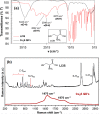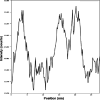Aqueous synthesis of red fluorescent l-cysteine functionalized Cu2S quantum dots with potential application as an As(iii) aptasensor
- PMID: 37362604
- PMCID: PMC10286222
- DOI: 10.1039/d3ra02886k
Aqueous synthesis of red fluorescent l-cysteine functionalized Cu2S quantum dots with potential application as an As(iii) aptasensor
Abstract
Water-stable Cu2S quantum dots were obtained by applying l-cysteine as a Cu(ii) to Cu(i) reducer and stabilizer in water and using an inert atmosphere at ambient temperature. The obtained quantum dots were characterized by STEM, XRD, FT-IR, UV-Vis, Raman, and fluorescence spectroscopy. The synthesis was optimized to achieve Cu2S quantum dots with an average diameter of about 9 nm that show red fluorescence emission. l-cysteine stabilization mediates crystallite growth, avoids aggregation of the quantum dots, and allows water solubility through polar functional groups, improving the fluorescence. The fluorometric test in the presence of the aptamer showed a shift in fluorescence intensity when an aliquot of As(iii) with a concentration of 100 pmol l-1 is incorporated because As(iii) and the used aptamer make a complex, leaving free the quantum dots and recovering their fluorescence response. The developed Cu2S quantum dots open possibilities for fluorescent detection of different analytes by simply changing aptamers according to the analyte to be detected.
This journal is © The Royal Society of Chemistry.
Conflict of interest statement
There are no conflicts to declare.
Figures











References
-
- Olga L. Rogelio C. Nadia P. Yolanda A. Melissa B. Diana O. Rev. Int. Contam. Ambient. 2017;33:281. doi: 10.20937/RICA.2017.33.02.09. - DOI
Grants and funding
LinkOut - more resources
Full Text Sources
Research Materials

